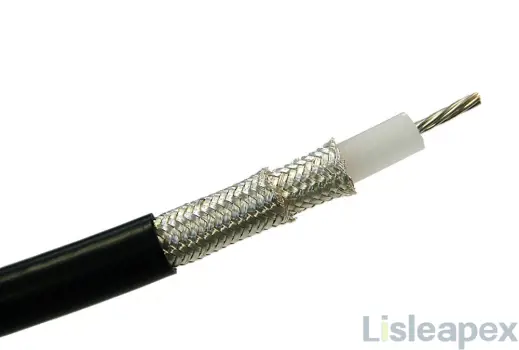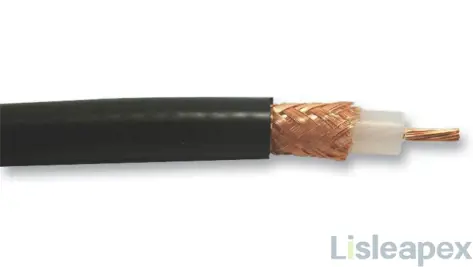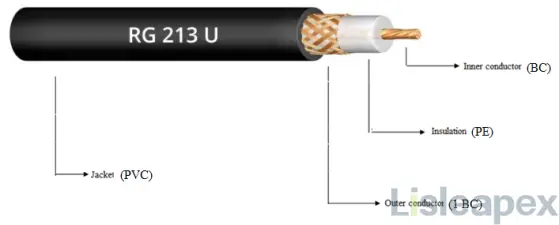In the realm of coaxial cables, RG214 and RG213 are two prominent players, each with distinct characteristics that cater to specific needs in the field of telecommunications and RF (Radio Frequency) applications. Understanding the differences between RG214 and RG213 is crucial for professionals, engineers, and enthusiasts looking to optimize signal transmission and ensure the integrity of their communication systems.
This article delves into the nuances of RG214 and RG213 cables, exploring their specifications, applications, and factors to consider when choosing between these high-performance coaxial cables.
RG214 Description
RG214 is a coaxial cable known for its exceptional performance in high-frequency applications, particularly in RF and microwave systems. The cable's construction includes a stranded silver-coated copper conductor, which enhances conductivity and minimizes signal degradation. Additionally, RG214 features a double-coated braid shielding and a PVC jacket, contributing to its durability and effectiveness in minimizing external interference. With a characteristic impedance of 50 ohms and a maximum temperature rating of 80°C, RG214 is well-suited for applications requiring high power handling and low signal loss at elevated frequencies.

RG213 Description
RG213 is another coaxial cable designed for RF and microwave applications. Its construction includes a stranded bare copper conductor, a single bare copper braid shielding, and a PVC jacket. While RG213 is also 50 ohms with a characteristic impedance, it differs from RG214 in terms of conductor material and shielding. The bare copper conductor and single bare copper braid make RG213 a more cost-effective option, though it may exhibit slightly higher signal degradation compared to RG214. With a maximum temperature rating of 75°C, RG213 is suitable for various applications where cost considerations are crucial.

RG214 vs RG213: Features
RG214 Features:
- Conductor: Stranded silver-coated copper.
- Shielding: Double-coated braid for superior interference protection.
- Jacket: PVC with an overall diameter of 0.425 inches.
- Weight: 138 lbs/mft.
- Electrical Specs: 5000V voltage rating, 50-ohm impedance, 32.2 pF/ft capacitance, max frequency of 11 GHz.
- Temperature Ratings: -40°C to 80°C.
- Attenuation: Lower signal degradation with a stranded silver-coated copper conductor.
RG213 Features:
- Conductor: Stranded bare copper for cost-effectiveness.
- Shielding: Single bare copper braid for basic interference protection.
- Jacket: PVC with an overall diameter of 0.405 inches.
- Weight: 110 lbs/mft.
- Electrical Specs: 5000V voltage rating, 50-ohm impedance, 32.2 pF/ft capacitance, max frequency of 11 GHz.
- Temperature Ratings: -40°C to 75°C.
- Attenuation: Slightly higher signal degradation compared to RG214 due to bare copper conductor.
RG214 vs RG213: Construction
RG214 distinguishes itself with a silver-coated copper conductor, whereas RG213 features a conductor composed of bare copper. Despite both conductors being stranded, their materials set them apart significantly. The silver-coated copper material in RG214 exhibits higher conductivity compared to the bare copper in RG213. Consequently, RG214 experiences less signal degradation.

RG214 Construction

RG213 Construction
In terms of shielding, RG214 boasts a double-coated braid, while RG213 features a single bare copper braid. The variations in both shielding and conductor materials contribute to the notable price difference between the two coaxial cables. RG213 is more economical due to its bare copper conductor and single bare copper shield, which are substantially less expensive than the silver coating featured in RG214. You could check the data below,
|
User |
RG214 |
RG213 |
|
Conductor Type |
Stranded |
Stranded |
|
Conductor Material |
Silver Coated Copper |
Bare Copper |
|
Dielectric Diameter |
0.285” |
0.285” |
|
Shield |
Double Silver Coated Copper Braid |
Single Bare Copper Braid |
|
Jacket |
PVC |
PVC |
|
Overall Diameter |
0.425” |
0.405” |
|
Weight |
138 lbs/mft |
110 lbs/mft |
RG214 vs RG213: Electrical Specifications
Examining the electrical specifications, RG214 and RG213 exhibit remarkable uniformity. Both cables demonstrate a robust capacity to endure high voltages, withstanding a rating of 5000V each.
Furthermore, they align seamlessly in terms of impedance, capacitance, and maximum frequency. The sole discernible distinction between RG214 coaxial cable and RG213 coaxial cable lies in their maximum temperature ratings. RG214 holds a slight edge in this regard with a rating of 80°C, whereas RG213 is rated at 75°C. The data is displayed as follows:
|
Electrical Specs |
RG214 |
RG213 |
|
Min. Temperature Rating (°C) |
-40 |
-40 |
|
Max. Temperature Rating (°C) |
80 |
75 |
|
Max. Voltage (V) |
5,000 |
5,000 |
|
Impedance (ohms) |
50 |
50 |
|
Capacitance (pF/ft) |
32.2 |
32.2 |
|
Max. Frequency (GHz) |
11 |
11 |
RG214 vs RG213: Attenuation
To gain a comprehensive understanding of coaxial loss, revisiting the details mentioned in the cable construction section can provide insights into the observed differences in attenuation. The presence of a stranded silver-coated copper conductor in RG214 facilitates a more efficient passage of electrical charges compared to the bare copper conductor in RG213.
|
Frequency (MHz) |
RG214 Loss (Attenuation dB/100ft) |
RG213 Loss (Attenuation dB/100ft) |
|
50 |
1.7 |
1.2 |
|
400 |
5.5 |
4.8 |
In essence, the key distinctions between the two cables predominantly arise from the conductor material, with RG214 featuring a silver-coated copper conductor, while RG213 utilizes a bare copper conductor.
RG214 vs RG213: Application
RG214 Application:
- High-Frequency Systems: RG214 is well-suited for applications requiring high-frequency performance, such as RF and microwave systems.
- Military and Aerospace: Its robust construction and enhanced shielding make RG214 suitable for military and aerospace applications where signal integrity is crucial.
- Data Transmission: RG214's low signal degradation makes it ideal for high-speed data transmission applications.
- Broadcasting: RG214's ability to handle high power and maintain signal quality makes it suitable for broadcasting applications.
RG213 Application:
- General RF Applications: RG213 is commonly used in general radio frequency applications where cost efficiency is a key consideration.
- CB Radio Systems: Due to its economical nature, RG213 is often employed in Citizen's Band (CB) radio systems.
- Ham Radio: RG213 is suitable for ham radio installations where moderate performance is acceptable, and budget considerations play a role.
- Short-Run Installations: In scenarios where the cable length is relatively short, RG213 provides a cost-effective solution for signal transmission.
RG214 vs RG213: Price Comparison
The price difference between RG214 and RG213 can be attributed to their distinct construction materials and features.
RG214:
The use of a silver-coated copper conductor and a double-coated braid for enhanced performance contributes to a higher manufacturing cost.
The overall design, including premium materials, results in a relatively higher market price for RG214.
RG213:
Utilizing a bare copper conductor and a single bare copper braid for basic shielding reduces the manufacturing cost.
The construction simplicity and more economical materials make RG213 a cost-effective alternative.
In summary, RG213 is generally more budget-friendly due to its simpler construction and the use of cost-effective materials, making it a preferred choice in applications where performance requirements allow for a more economical solution. RG214, with its enhanced features, is priced higher to reflect the additional performance benefits it offers, making it suitable for applications where superior performance is critical. The choice between RG214 and RG213 often involves a trade-off between performance and cost considerations based on the specific needs of the application.
Datasheet
Download RG213 and RG214 datasheet PDF here>>
Conclusion
In summary, both RG214 and RG213 serve as reliable choices in the realm of coaxial cables, offering distinct features that cater to specific needs. RG214 stands out with its silver-coated copper conductor and double-coated braid shielding, providing enhanced performance but at a higher cost. Meanwhile, RG213, with its bare copper conductor and single braid shielding, offers a more economical alternative without compromising basic performance parameters. The choice between RG214 and RG213 depends on the specific requirements and budget considerations of the application at hand.
訂閱時事通訊,了解 亮辰科技 的最新動態


 恭喜您提交成功
恭喜您提交成功
 提交失敗
提交失敗